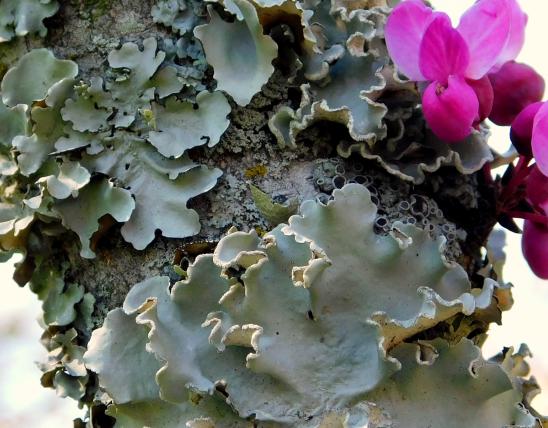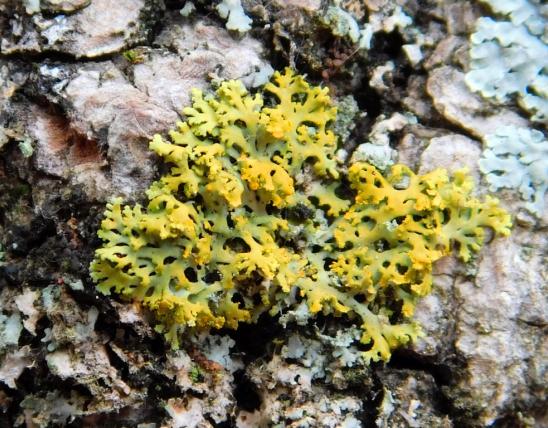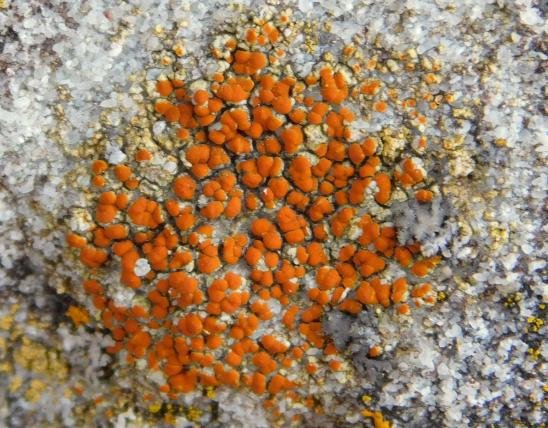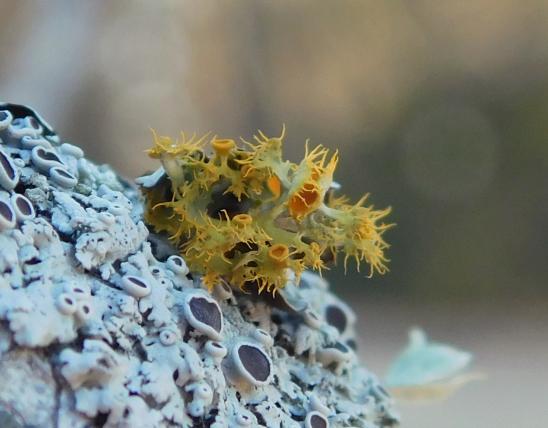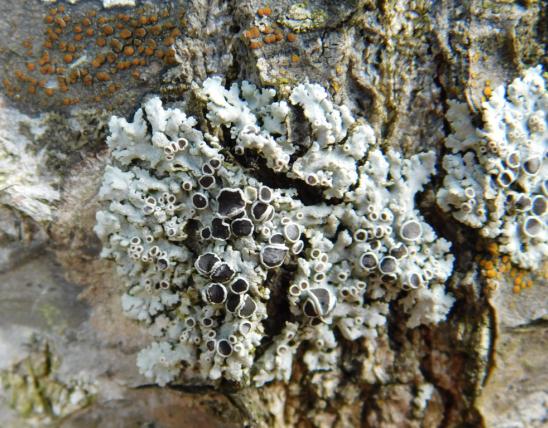
Orange sunburst lichens can be very common on sunny rocks and tombstones. They are typically orangish or yellow orange (usually not greenish yellow). They have a circular, foliose growth pattern with tiny, branching lobes that are often fairly convex (out-curved) or cylindrical in cross-section. The foliose rosette pattern can be difficult to see when these lichens coalesce into large masses of tiny scale-like fragments and portions break off.
The scalelike fragments are described by specialists as squamulose, which means scalelike or scaly. Thus these lichens have a squamulose foliose growth habit.
When members of this genus have apothecia (disk-shaped spore-bearing structures), the disks have rims that are the same color as the rest of the lichen. Typically, the center of the disk is darker orange, while the rim and the rest of the lichen are lighter and more yellow-orange.
Like other foliose lichens, the rosettes of orange sunburst lichens are lobed, frilly, or leafy, somewhat like foliage. The lower surface of foliose lichens is usually a different color than the top surface.
A lichen is an organism that results when a fungus species and an algae species join together. Although the relationship between the fungi and algae is quite intimate and integrated, the lichen that is formed does not much resemble either of the components. Learn more about lichens on their group page.
Missouri has at least three species in this group:
- The orange wall lichen (X. candelaria; sometimes Polycauliona candelaria) may grow on rock or bark, usually in sunlight and in places where organic materials collect. It usually forms small cushions. The lobes are narrow; soredia (tiny packets of lichen that break away easily to form new lichens elsewhere) are formed along the edges. Apothecia (disk-shaped spore-bearing structures) are rare. This widespread “species” is extremely variable, and specialists agree that it requires further study. It probably represents more than one species. It’s quite possible that the orange wall lichens found in the Midwest — for years, lumped into X. candelaria — are an undescribed separate species.
- The hooded sunburst lichen (X. fallax) may grow on bark, limestone or dolomite rock, or cemetery stones, usually in full sun. It forms rosettes with narrow lobes; the lobe tips typically curl around to expose crescent-shaped (“hooded”) slits, which open to release soredia (tiny granular packets of lichen that break away easily to form new lichens elsewhere). These fluffy crescents often look something like tiny bowls filled with cereal, or baskets or birds’ nests. This lichen rarely forms apothecia (disk-shaped spore-bearing structures). This is one of the species that is now often placed in genus Xanthomendoza.
- The pin-cushion sunburst lichen (X. polycarpa; sometimes Polycauliona polycarpa) usually grows on bark and twigs and forms small cushions. It typically has many apothecia (disk-shaped spore-bearing structures), which are crowded in the center of the lichen. The lobes are short, narrow, and convex (rounded, as if slightly puffed up).
Similar species: Several other lichens have yellow or orange, flamelike colors. Some of these, like orange sunburst lichens, can be confusing, because their growth form could be misinterpreted as crustose or foliose. The names can be confusingly similar, too.
- Firedot lichens (Caloplaca spp.) are crustose lichens that attach tightly to their substrate. They typically have no lower surface, but sometimes they grow in round patterns with edges that can be so wrinkled they appear foliose, and the centers die and fleck away. They are usually orange, yellow, rusty, or brown and typically look like little dots on a surface. They mostly grow on rocks, concrete, or tombstones. In the same family as orange sunburst lichens.
- Goldspeck lichens (Candelariella spp.) are orange-yellow crustose lichens that are frequently seen growing on rock or wood substrates. They are unlikely to be misinterpreted as foliose, as they usually look crusty, with small apothecia cups/buttons.
- Candleflame lichens (Candelaria spp.), are tiny to small, greenish-yellow or mustard-colored foliose lichens that grow in a branching, rosette form. As with orange sunburst lichens, use a hand lens, or a camera that takes good closeups, to see the delicate, small, branching lobes. Sometimes, when they grow in masses, it’s hard to see their branching, rosette form. Missouri has two species; both typically live on tree trunks. They are not orange.
- Gold-eye lichen (Teloschistes chrysophthalmus) might be mistaken for the pin-cushion sunburst lichen (X. polycarpa), because it, too, typically grows on branches and bears a profusion of orange apothecia with yellow rims. But it is a shrubby lichen, with hairy branches all arising from a central point, growing like a tuft. Also, the cup rims often have bristles radiating outward from the rim like eyelashes. (The pin-cushion sunburst lichen X. polycarpa has sometimes been placed in the same genus as gold-eye; they are in the same family.)
Rosettes usually only reach about 1 inch in diameter. However, groups of these lichens may coalesce to cover rather large areas, several inches in length or diameter.
Statewide.
Habitat and Conservation
See the descriptions (in the Description section) of our different orange sunburst lichen species for their particular habitats.
Like other types of lichens, different species of foliose lichens have certain habitat preferences. Some grow mostly on rocks, others on wood, others on soil or other places such as sidewalks or tombstones. Thus, knowing habitat preferences can help to identify species.
Status
When you are learning about orange sunburst lichens, be prepared to find them listed under a variety of genera. The genus name has been in flux, and some references use the name Xanthoria for all, while others keep some species in genus Xanthoria while placing others into genus Xanthomendoza, based on the presence of rootlike structures and microscopic differences in spore structure.
Some orange sunburst lichen species have been placed in genus Polycauliona, too, and in the past, some have been placed in Teloschistes, Lecanora, and other genera.
In the past, researchers used visible structures, growth form, chemical reactions, and microscopic details to figure out the relationships among lichens. Now, research in family Teloschistaceae focuses on their DNA. The goal is to create names and classifications that reflect the true genetic/ancestral relationships among the species.
Life Cycle
Lichens can reproduce sexually (via spores) or vegetatively (asexually).
- Not all lichens in a group necessarily produce the same types of reproductive structures. In the orange sunburst lichen genus, it is very helpful to be able to distinguish between the different kinds of reproductive structures.
Sexual reproduction in lichens occurs in much the same manner as other fungi. Special structures called apothecia give off spores, which are created as the result of a fusion of gametes (sperm and ova) that occurs in the apothecia tissues. Apothecia, when they occur in this genus, are disk-shaped and look something like tiny suction cups.
- When lichens reproduce via spores, only the fungal component is reproduced. The germinating fungal spore must quickly attach to a suitable algal partner, or it perishes.
Soredia are tiny ball-like packets of fungus and algae that form under the top surface of the lichen (cortex), then erupt from breaks in the cortex, rather like tiny pimples. The tiny pimple-like breaks in the cortex are called soralia. Patches where clusters of soredia are forming make that part of the lichen look rough and dry: fluffy, grainy, or mealy.
Human Connections
Lichens contribute to a beautiful landscape. In desert, alpine, tundra, or other rocky habitats, they can coat rocks with a riot of bright colors — neon yellows, oranges, and greens — which intensify after a rain. In Missouri, good places to see lichens on rocks include glades and the rocky tops (“balds”) of Ozark hills.
In the 1800s, the English essayist and art commentator John Ruskin wrote lovely prose about lichens, including what were undoubtedly orange species of Xanthoria: “In one sense the humblest, yet in another they are the most honored of the earth-children. . . . Strong in lowliness. . . . Sharing the stillness of the unimpassioned rock, they share also its endurance; and while the winds of departing spring scatter the white hawthorn blossom like drifted snow, . . . far above, among the mountains, the silver lichen-spots rest, star-like, on the stone; and the gathering orange stain upon the edge of yonder western peak reflects the sunsets of a thousand years.”
Ecosystem Connections
You may notice that orange sunburst lichens are described as foliose (leafy), while their close relative gold-eye (Teloschistes chrysophthalmus) is described as fruticose (shrubby), and some other close relatives (such as the firedot lichens, Caloplaca spp.) are described as crustose (crusty). Keep in mind that growth form is only descriptive, and it may not reflect true family relationships. This is similar to the case with the rose family, whose members may take the form of trees, shrubs, or nonwoody plants (think of cherry, almond, and apple trees; rose, blackberry, and spirea bushes; and strawberries and cinquefoils).












Mosses, liverworts, hornworts, and lichens seem rather similar, but these organisms are in very different groups. Mosses, liverworts, and hornworts are small, low plants usually found in damp habitats. Unlike more familiar plants, they lack veinlike structures and do not produce flowers or seeds — instead, they produce spores. Meanwhile, lichens are not plants at all: they are a collection of different fungi that have photosynthetic algae living within their tissues.






















